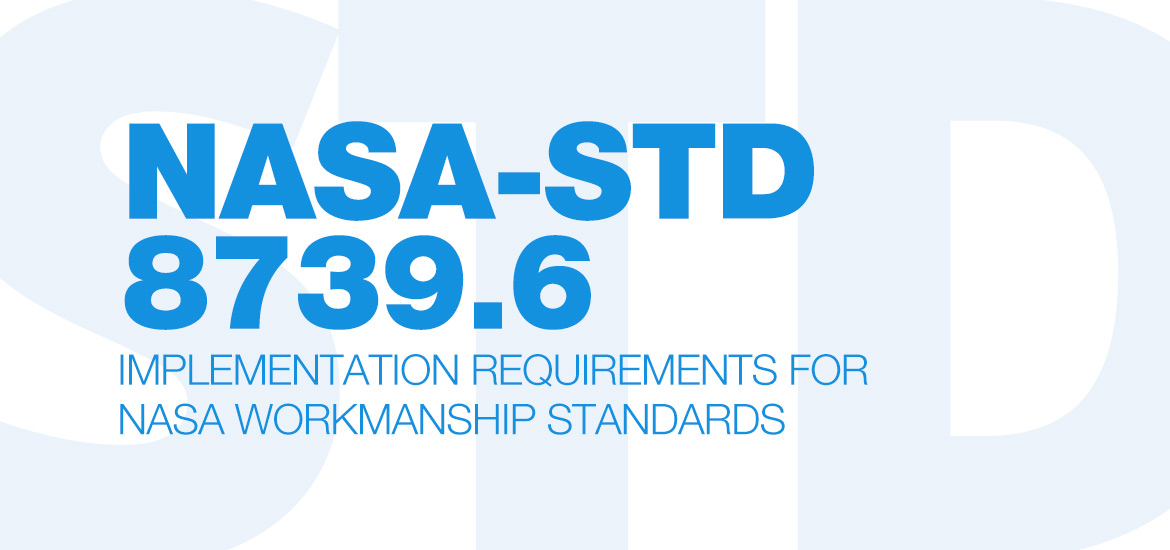Update to Implementation Requirements for NASA Workmanship Standards Published
August 25, 2016
3-minute read

Update: This article was updated to reflect that Alvin Boutte is now the Point of Contact for questions regarding Workmanship Standards.
NASA-STD-8739.6A, Implementation Requirements for NASA Workmanship Standards was updated and released on June 30, 2016. The revised standard, effective for five years, includes significant technical updates and corrections. This update was one of three recently publish standard updates, which included NASA-STD-8739.1B, Workmanship Standard for Polymeric Application on Electronic Assemblies and NASA-STD-8739.4A, Crimping, Interconnecting Cables, Harnesses, and Wiring.
The following is a brief summary of the changes, but to learn more, review the Document History Log in the front of the standard document:
- Requirements that were generic to all NASA Workmanship standards were moved into this standard. Examples include requirements traceability in suppliers’ procedures, use of alternate standards, use of nonstandard configurations and laboratory environment conditions.
- Missions that are executed per NPR 7120.8, NASA Research and Technology Program and Project Management Requirements are now considered out-of-scope (exempt from) for the Workmanship requirements in NASA-STD-8739.6 and the individual technical standards it references.
- The standard definitions in NASA-STD-8709.22, Safety & Mission Assurance Acronyms, Abbreviations, & Definitions, for the terms “rework” and “repair” now apply. Definitions for alternate standards, manufacturing documentation, off-the-shelf, referee magnification levels and supplier were added.
- Clarifying language was provided for laboratory temperature and relative humidity conditions. Risk mitigations are now allowed as standard practice when low humidity working conditions in Electrostatic Discharge (ESD)-controlled areas are routinely encountered.
- Project requirements are referred to as the primary source of calibration control requirements rather than defining them within the Workmanship standards. NASA-STD-6016, Standard Materials and Processes for Spacecraft, is referenced as the primary source for contamination control requirements (e.g., outgassing and offgassing).
- A clarification was added that all mission hardware workmanship shall be inspected.
- Specific criteria was specified as the minimum that must be addressed when seeking approval for use of nonstandard solvents.
- Water as a cleaning solvent for applications that use silver-plated copper wire was prohibited. An exemption from the red-plague control plan requirements in J-STD-001FS is provided. This section of J-STD-001FS is expected to be downgraded from a “shall” statement to a “should” statement in a future revision.
- Use of “anti-static” containers (e.g., Pink Poly) for storing or transporting ESD sensitive items is prohibited.
- Clause 11 of J-STD-001FS, the IPC’s soldering standard, is not applicable for torque striping of fasteners. The torque striping requirements in NASA-STD-8739.1, Polymeric Applications, apply.
- Requirements and information related to the IPC nonmodular training program for J-STD-001FS were removed. IPC no longer supports the nonmodular training program.
- Allowance was added for the use of J-STD-001FS instead of NASA-STD-8739.3, Soldered Electrical Connections (cancelled) when NASA-STD-8739.3 is referenced by NASA-STD-8739.4, Crimping, Interconnecting Cables, Harnesses, and Wiring.
- Certification requirements for operators and inspectors were removed, however biennial training requirements were retained. Level B trainers who work within supplier Level B training programs also are no longer required to be certified. Neither of these changes relieve the supplier from ensuring the competency of their operators, inspectors or instructors and this expectation and requirement were reinforced in Appendix A.
- The grace period of three months attached to the retraining requirement was removed.
- Sharing of Export Administrative Regulations information with foreign national students was prohibited.
Making the Updates
Three hundred and forty comments were received for the A revision of this standard. The acceptance rate for the comments that were received was 82 percent. Of the comments that were not accepted, many were related to adjustments to standard language or standard NASA document formats, or were out of scope for the document (e.g., language specific to levying of contracts or waiver acceptance processes). Results from a recent NASA self-audit found the need to clarify definitions and requirements for Level B instructors who work within NASA centers; these requirements are being examined at this time by the NASA Workmanship Standards Technical Committee (see https://nepp.nasa.gov/index.cfm/5529 for members) and clarifying language is expected to be developed and added in the next revision of the standard.
Questions about the standard or suggestions for improvements may be addressed to Alvin Boutte.